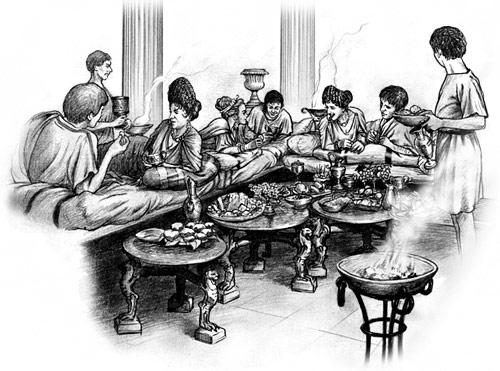The History
Truffle
Babylonians, Romans, the banquets of the Renaissance: let's retrace it together.

To tell the story of the truffle is to tell the history of world civilisation.
Alexandre Dumas
The strong and rooted presence of truffle in the traditions of Roero, Langhe and Monferrato and the passion that drives the searchers – called in Piedmontese “trifulau” – to venture, with their faithful and infallible dogs, in search of this beloved and mysterious mushroom, lead us to delve into its history.
A frank product of the earth, which requires minimal intervention to be made edible, truffles have always exerted great fascination both for what concerns the strictly botanical aspect and for its use in the culinary field.
The first historical notes
The world of truffles has always been shrouded in charm and mystery: the first news we have date back to the time of the Babylonians and that territory called Fertile Crescent, around 3000 BC.
In fact, from some writings it emerges that they procured truffles among the sandy shores and sands of the desert, of quality and species far from those we know today, but still an incredible gift of the earth. What they brought to the table was Tarfezia Leonis, widely spread in Anatolia.
It is said that even the pharaoh Cheops (2600 BC) was fond of truffles and consumed them cooked.
Ancient Greece
To get closer geographically, we must wait for the advent of Greek culture. In fact, it seems that the ancient Athenians appreciated the truffle to the point of conferring honorary citizenship on a certain Cherippo for having invented new and tasty recipes based on this ingredient.
We also find hints of the truffle in the Historia Plantorum of the Aristotelian philosopher Theophrastus, who used the term “ydnon” to refer to the hypogeum mushroom from which the word Indology (the science that studies truffles) was then coined.
The Roman Empire
Based on the data provided by Pliny in his Historie Naturalis, the Romans were also greedy consumers of this mushroom, which came to the capital directly from “dry, sandy and fruitful Africa”.
In the imperial age, therefore in the first centuries after the birth of Christ, the first recipes appeared that governed the use of truffles in numerous particularly sought-after dishes that served in the rich tables of the Roman nobility; it is also said that they were not used to cut them, but to consume them whole.
In the literary sources of the time, however, there is a certain embarrassment in defining this precious ingredient, to the point of not knowing whether it was a vegetable or an animal.
Juvenal became so infatuated with the truffle that he went so far as to write that “it was preferable that the wheat be missing than the truffle” and defined it together with Galen, Pliny and Martial as “son of lightning“, attributing its origins to the thunderbolts thrown by Jupiter on the earth to favor the birth of these “divine fruits“.
Studies and botany
This confusion seemed to persist throughout the Middle Ages, considering that for a long time no substantial data were acquired and the scientific information of the time tended not to question the reliability of what was reported by classical sources.
We have to wait until the 18th-19th century for botanical studies to begin to clarify the nature of this mushroom.
The contribution of the Milanese botanist Carlo Vittadini was fundamental in the research. In 1831 he published his Monographia Tuberacearum, a systematic study of the various truffle species that eliminated the confusion that reigned on the subject and laid the foundations of modern Indology.
The Renaissance table
From the gastronomic point of view, after the darkness that affected the medieval centuries, the truffle reappeared triumphantly in the Renaissance period on the table of the main Piedmontese, Italian and European courts.
In the 1700s a real mania for gastronomy was born: there was no illustrious person who wasn’t involved with the truffle.
Several anecdotes associate this delicious ingredient with public figures such as Caterina de ‘Medici, who seems to have recognized the introduction of the truffle at the court of France, or Lucrezia Borgia, who instead used it to increase her charm given the many beliefs about its aphrodisiac powers.
Even the king apparently cooked the eggs creating exquisite “omelettes aux truffes”.
Madame Pompadour linked her name to the “soupe à la Pompadour”, in which the black truffle cannot be missing.
Rossini, the composer, appreciated the virtues of flavor: one of his best recipes were the slices of fillet sautéed in butter, placed on a toasted bread stuffed with foie gras and black truffles.
The Piedmontese truffle, between yesterday and today
Alba, a land of truffles now par excellence, the place where the “white truffle” is celebrated, owes much of its fame to its most important ambassador, Giacomo Morra, who with political-strategic skills was able to make the truffle and Alba known to all the world.
He understood what the possibilities of the Piedmontese white truffle were and in 1928 he gave birth to the famous Truffle Fair.
After the war, as a true marketing ace, he began to ship some pieces to world-class personalities: Henry Truman, Marilyn Monroe, Joe Di Maggio and Winston Churcill.
Although in the post-war period knowledge, appreciation and the modern way of consuming truffles began to spread, it was necessary to wait until the second half of the Eighties and the sensational success of Italian wine and cuisine in the world to see truffles assert themselves as a sublime and precious food.
In these years an unprecedented media communication with guides, specialized periodicals, television and the web developed, which brought the truffle to a sudden worldwide success.
